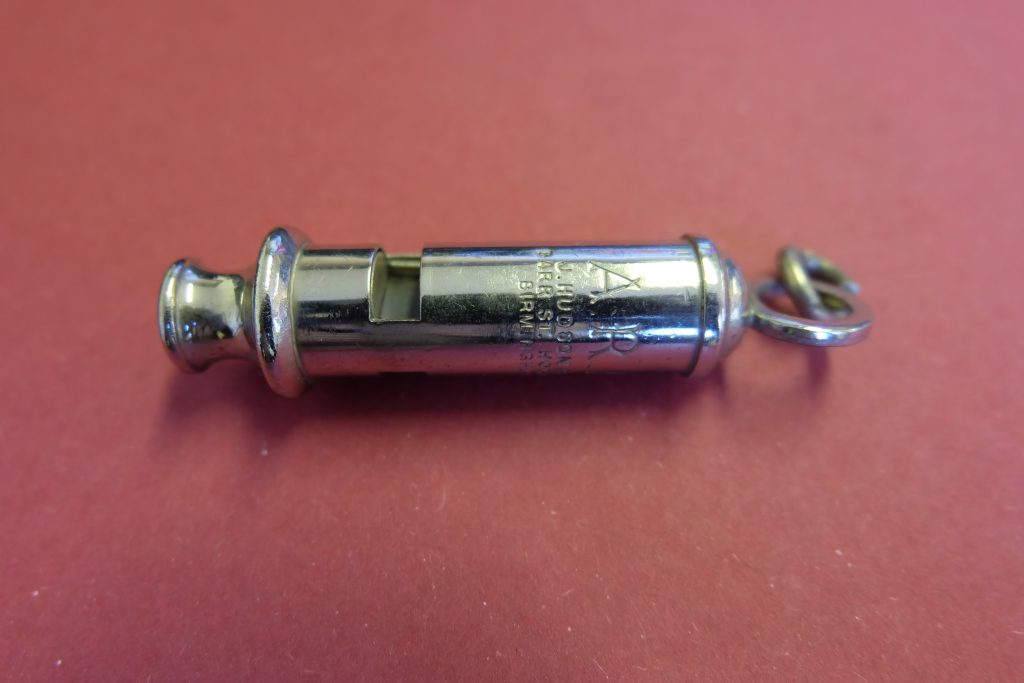October’s Object of the Month is an Air Raid Precautions (ARP) whistle, dating from World War II. It is one a collection of ARP whistles that were donated to Ripon Museum Trust by West Yorkshire Police. The whistles are not currently on display but stored and cared for in our museum store.
ARP whistles are essentially the same as standard police whistles but they had a much wider use in World War II. The whistles were particularly effective during the Blitz, a German bomb attack against Britain in 1940-1941, when they were used to direct and control crowds of panicked civilians, providing a more effective alternative to shouting over the explosions of bombs and the wail of air-raid sirens. The whistles were used throughout the country and each of the 1.4 million Air Raid Precautions Wardens carried one.
Although not a major population centre, Ripon was not immune from the dangers of bombings. A young boy living in Ripon remembers “learning about air raids and what to do when the air raid sirens sounded. The sirens made a loud wailing noise to warn us that an air raid was possibly coming. Then, after a while, the All Clear sounded and I do remember feeling relieved” (http://www.bbc.co.uk/history/ww2peopleswar).
The whistles in the museum’s collections are nickel-plated and when blown, they emit a piercing two note screech. The whistles are stamped with the letters ‘A.R.P.’ and the details of the manufacturer, J Hudson and Co of Birmingham. During World War II, the company made ARP whistles, as well as police whistles and whistles for the armed forces. Ironically their factory suffered a direct hit from a German air raid in October 1940, causing major damage but no injury. The company continues to make about 5 million whistles today under the name Acme Whistles but it no longer produces police whistles except for ceremonial purposes, instead making whistles for a variety of other purposes, including dog whistles, sports whistles and whistles for outdoor and country.
J Hudson and Co was founded in the 1870s in Birmingham by Joseph Hudson. Hudson can be credited with the development of police whistles on a large scale. A toolmaker by trade, in 1883 he submitted the winning design when the Metropolitan Police Force asked the public for a whistle that would be cheap, small, easy to manufacture and distinctive in tone. After a demonstration at Scotland Yard, Joseph had his first sale and by 1884 his first contract for 21,000 whistles.
Before the 1880s, policemen carried a police rattle rather than a whistle. This was a wooden spinner that made a loud clicking noise. Some of you may also remember the use of rattles when attending football matches. Some early rattles folded up for easy storage and so could fit into uniforms. The rattle of Samuel Winn [link to blog post], Ripon’s first policeman who was appointed in 1830, can be seen on display in our Courthouse Museum. Although rattles provided a means for policemen to call for help, they were bulky, and awkward to get out of the pocket, while it was soon found that a whistle could be heard over twice the distance compared to a rattle. Despite being quickly replaced by whistles in the late 1800s in many police forces, rattles made a bit of a return during World War II, where they were used by Air Raid Precautions Wardens to alert citizens to the possibility of a gas attack.
Police whistles were phased out operationally in the 1970s, when the advent of handheld radios removed the need for them. The development of personal and pocket phone radios is described in the displays at our Prison & Prison Museum. Although in recent years a few forces have experimented with the return of police whistles, their role today remains largely ceremonial.
